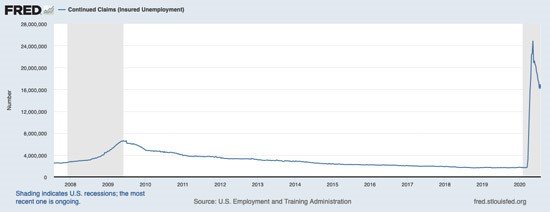Back in my college days as a chemical engineering student, I found myself driving down to Kingsport, Tenn. I was due to start a cooperative education job at the Eastman Kodak Co. (NYSE: KODK) chemical plant there.
I remember looking at the biggest chemical plant in the world with awe (13,000-plus employees at the time). Kodak sold off its chemical business - now Eastman Chemical Co. (NYSE: EMN) - in 1994.
This former employer of mine has been in the news a lot lately. Through a $765 million loan from the Trump administration, it was set to revive the U.S. pharmaceutical industry.
As the news hit and the Robinhood trading crowd piled in, shares soared from $2 to more than $60 in two short days. Hope and optimism ruled.
A few days later, reality set in. The stock cratered. It's now around $10 and trending down.
This is an example of what we in the trading world call "Buy the Rumor, Sell the News."
When a rumor first hits the news feeds, it creates excitement and optimism. Stocks rise, and other traders don't want to miss out.
But things are rarely as rosy as they look at first glance. Once reality sets in, excitement gives way to reason. People start looking into the actual details of the matter.
And more often than not, it turns out that in their excitement, traders overshot.
Kodak's pharmaceutical loan was one example.
But that's small potatoes compared to what's coming next. Kodak was just one company.
This time, stock markets as a whole could be in for a "sell the news" moment. That's why today, I'm going to show you how to avoid the hype and what to do instead to come out on top...
Kodak Got a "Kodak Moment" - and Then It Was Gone
As is often the case with these "sell the news" moments, everything seems to line up - until it doesn't. On July 28, the Trump administration announced that Kodak, known mostly for its photography and film chemicals business, was set to receive a $765 million loan.
In return, the company would start making pharmaceuticals to reduce America's reliance on Indian and Chinese factories, which have proved so unreliable during this pandemic. For a company with a market cap of $200 million at the end of 2019, that loan was huge. So was the vote of confidence that Kodak could make the switch to making drugs.
When the news hit, traders couldn't buy Kodak shares fast enough. Volume skyrocketed, and especially traders using the Robinhood app went berserk for the stock.
Then the reality set in. People began questioning whether Kodak could really switch from making photography chemicals to highly exact and tightly regulated pharmaceuticals. Even if it was successful, surely this would take years or at least several quarters - with many bumps along the way. And definitely too long a time for the stock to go up by thousands of percentage points in a day.
In addition, news came out that executives at Kodak may have been insider-trading to profit from the announcement. The loan has now been suspended pending an investigation, and Kodak's shares are plummeting down below $10.
The cold, hard reality toned down the optimism and made people look into what was actually happening and think through the implementation of the loan.
On closer inspection, what had looked like a sure-fire, no-brainer win for Kodak turned out to not be that amazing.
Moving into the pharmaceutical space isn't easy.
Right now, something similar may be happening, but on a much larger scale...
The Pressure Is on Washington for Another Stimulus... Eventually
As I'm writing this, Democrats and Republicans in Congress, as well as the Trump White House, are throwing blame at each other (no surprise there).
The $600 unemployment supplement payment lapsed at the end of July, and other stimulus measures such as the small-business Paycheck Protection Program also need to be extended. Just look at this chart from the Fed of how many Americans have applied for at least a second week of unemployment benefits:

That's over 16 million Americans out of work, or over 10% of the workforce. As you can see, even at the height of the 2008 financial crisis, unemployment numbers were nowhere near these levels.
With millions of Americans out of work, some states re-imposing restrictions as COVID-19 resurges, and a general election in three months, the pressure is on D.C. to come up with another package.
So far, they've failed.
Democrats want a return of the $600 payment as part of a $3 trillion stimulus bill. Republicans want a $1 trillion bill, with lower unemployment payments and liability immunity shielding employers from civil suits if employees catch COVID-19 while working. Both agree that another round of stimulus checks of $1,200 or so should go out.
Originally, Republicans wanted a more tailored unemployment payment of about 70% of whatever the person made at their last job. This was something considered earlier this year as well, but rejected. Unfortunately, the computer systems used by state unemployment agencies are so old and outdated, there's no way of making payments like that.
So the red team settled on keeping the payment lower than $600 to reduce the risk that people would choose to take unemployment money and not return to work.
To that, the president has added a request to lower or suspend the payroll taxes that fund Medicare and Social Security, a proposal that both parties in Congress dislike.
On Friday, at a "last-ditch" meeting, Democrats proposed a $2 trillion compromise package, down from their original $3 trillion, hoping Republicans would meet them in the middle. That didn't work.
And news of more stimulus impasses, this time inside the Democratic Party, sent the market temporarily down this week. But the markets seem to shrug off this type of stimulus negotiation struggle pretty easily.
Traders Are Bullish on Their Idea of the Stimulus, Not the Actual Deal
Yes, there were a couple of times when news that negotiations had "broken down" or were "at a standstill" sent overnight trading down a couple hundred points.
Each time, those losses had been made up for and then some by the time markets opened the next morning. Like we saw on Wednesday.
Trader sentiment is clear here. First of all, it's not like the markets really need another stimulus package right now. There's still plenty of fuel left over from previous deals, pushing stocks higher. Not to mention the Fed's unwavering commitment to flooding financial markets with money.
That's not to say Americans and America don't need another stimulus package. Tens of millions of people are unemployed, and in some areas where COVID-19 is surging, the extra unemployment payments were a lifesaver.
Small businesses are also at risk unless business stimulus programs get renewed. But for the stock market and the large corporations that have been rallying the most since March, these new stimulus plans don't mean much. Unlike past stimulus bills, where the need for money was urgent, traders are OK waiting it out this time.
The second reason why traders are taking the ineffective negotiations in Washington in stride is simple. Everyone believes a deal will get done eventually. After all, it's an election year.
The idea that Congress or the president would fail to help the many millions unemployed people, for example, just three months before an election is hard to fathom. There could hardly be a better opportunity for Big Government politicians from both sides of the aisle to show their "generosity."
Of course, the upcoming election is also the reason why negotiations are taking longer. With less of a sense of urgency this time, politicians have to make a show of toeing the party line and serving (or even riling up) their base. Once those theatrics are done, they'll sit down and hammer out a deal. That's the feeling among traders, at least.
And that's what's got me worried. Because as long as the deal itself is in flux, markets are going up simply on the promise that there will be a deal. It's a promise without any specifics.
A perfect setup for a "Buy the Rumor, Sell the News" event.
As long as negotiations go on but we all know there'll be a deal eventually, we're trading on hope and optimism, but without details.
When the stimulus bill is finally announced and we got to see it, warts and all, reality is going to set in. We're going to get to see who exactly gets what, how much it will cost, and how much it will affect different companies.
Suddenly, some traders may come to a rude awakening and realize that some sectors won't get much stimulus at all. And what we're likely to end up with is a mishmash of a compromise that helps fewer people and doesn't really move the economic needle.
That's why I suggest trading cautiously for now. Traders have already priced this stimulus deal in, so they aren't worried about negotiations dragging on.
But the deal they've priced in is the one in their head, not the one that's going to appear on paper soon.
When hope and reality meet, there's a good chance traders will be disappointed. Especially if the stimulus is a bit ho-hum, which is likely thanks to the tough negotiations. And we have a big-time resistance level in the market directly overhead in the S&P 500 at 3,393, which could give the market a pause or even lead to some profit taking.
But don't worry; with all that stimulus money out there from central banks and government bodies, it won't take long for a lion's share to find its way back in the stock market to start another bull leg up. So treat this sell-the-news moment as a yet another chance to buy your favorite stocks on a pullback.
And with my colleague Shah Gilani's latest presentation, you'll know exactly what stocks to buy - and which ones to avoid at all costs...
You see, Money Morning Chief Investment Strategist Shah Gilani will be flying through stocks - more than 50 - telling you which to consider buying NOW and which to drop like a ton of bricks.
These picks will be coming fast and furious. (Make no mistake: This event will be rapid-fire - you will want to take notes.) Click here now to get started...
Follow Money Morning on Facebook and Twitter.
About the Author
D.R. Barton, Jr., Technical Trading Specialist for Money Map Press, is a world-renowned authority on technical trading with 25 years of experience. He spent the first part of his career as a chemical engineer with DuPont. During this time, he researched and developed the trading secrets that led to his first successful research service. Thanks to the wealth he was able to create for himself and his followers, D.R. retired early to pursue his passion for investing and showing fellow investors how to build toward financial freedom.



